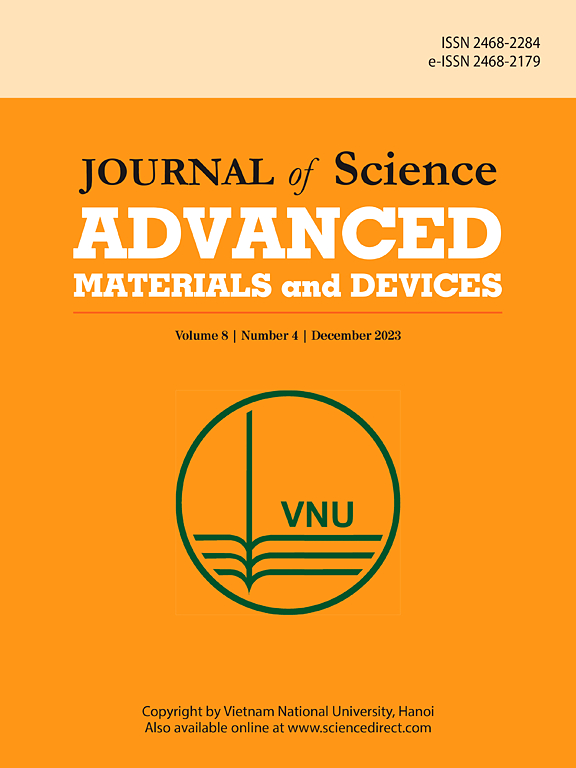IF 6.7
3区 材料科学
Q1 MATERIALS SCIENCE, MULTIDISCIPLINARY
Journal of Science: Advanced Materials and Devices
Pub Date : 2025-03-13
DOI:10.1016/j.jsamd.2025.100875
引用次数: 0
摘要
这篇综述探讨了作为磁共振成像造影剂的氧化铁纳米粒子(IONPs)的研究进展,强调了它们的合成、表面工程以及对磁共振成像造影增强的影响。虽然钆基造影剂(GBCAs)仍是T1加权成像的临床标准,但其安全性问题促使人们将IONPs作为有前途的替代品进行研究。超小型 IONPs(5 纳米)具有很强的 T1 对比增强效果,而较大型 IONPs(20 纳米)由于具有很高的 r2 弛豫度,因此具有很好的 T2 对比效果。此外,T1/T2 可切换 IONPs 的最新进展还能通过控制尺寸、形状和刺激响应性表面修饰实现动态对比度调节,从而增强肿瘤成像的特异性。本综述探讨了各种表面工程策略,包括蛋白质、多糖、聚合物、脂质、介孔二氧化硅和混合涂层,这些策略可提高生物相容性、循环时间和靶向效率。尽管 IONPs 潜力巨大,但在临床转化方面仍面临挑战,包括监管障碍、靶向效率不一致以及长期安全性问题。通过优化配方、以生物相容性为重点的设计和严格的临床前评估来解决这些局限性,对其成功融入临床磁共振成像诊断至关重要。我们的研究结果表明,IONPs 不仅能缓解传统造影剂的许多局限性,还能为精准成像和个性化医疗铺平道路,重新定义磁共振成像造影技术的未来。本文章由计算机程序翻译,如有差异,请以英文原文为准。

Iron oxide nanoparticles enhancing magnetic resonance imaging: A review of the latest advancements
This review explores the advancements in iron oxide nanoparticles (IONPs) as MRI contrast agents, emphasizing their synthesis, surface engineering, and impact on MRI contrast enhancement. While gadolinium-based contrast agents (GBCAs) remain the clinical standard for T1-weighted imaging, their safety concerns have driven research toward IONPs as promising alternatives. Ultra-small IONPs (<5 nm) exhibit strong T1 contrast enhancement, while larger IONPs (>20 nm) provide superior T2 contrast due to their high r2 relaxivity. Additionally, recent developments in T1/T2 switchable IONPs enable dynamic contrast modulation through controlled size, shape, and stimuli-responsive surface modifications, enhancing tumour imaging specificity. This review examines diverse surface engineering strategies, including protein, polysaccharide, polymer, lipid, mesoporous silica, and hybrid coatings, that enhance biocompatibility, circulation time, and targeting efficiency. Despite their potential, IONPs face challenges in clinical translation, including regulatory hurdles, inconsistent targeting efficiency, and long-term safety concerns. Addressing these limitations through optimized formulations, biocompatibility-focused designs, and rigorous preclinical evaluation will be crucial for their successful integration into clinical MRI diagnostics. Our findings suggest that IONPs not only mitigate many limitations of conventional contrast agents but also pave the way for precision imaging and personalized medicine, redefining the future of MRI contrast technology.
求助全文
通过发布文献求助,成功后即可免费获取论文全文。
去求助
来源期刊

Journal of Science: Advanced Materials and Devices
Materials Science-Electronic, Optical and Magnetic Materials
CiteScore
11.90
自引率
2.50%
发文量
88
审稿时长
47 days
期刊介绍:
In 1985, the Journal of Science was founded as a platform for publishing national and international research papers across various disciplines, including natural sciences, technology, social sciences, and humanities. Over the years, the journal has experienced remarkable growth in terms of quality, size, and scope. Today, it encompasses a diverse range of publications dedicated to academic research.
Considering the rapid expansion of materials science, we are pleased to introduce the Journal of Science: Advanced Materials and Devices. This new addition to our journal series offers researchers an exciting opportunity to publish their work on all aspects of materials science and technology within the esteemed Journal of Science.
With this development, we aim to revolutionize the way research in materials science is expressed and organized, further strengthening our commitment to promoting outstanding research across various scientific and technological fields.
 求助内容:
求助内容: 应助结果提醒方式:
应助结果提醒方式:


